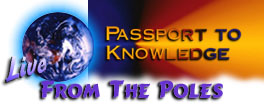

A PASSPORT TO KNOWLEDGE SPECIAL
|
Debuting as part of NSF's 17th annual National Science
and Technology Week, whose theme in 1998 was: POLAR
CONNECTIONS: EXPLORING THE WORLD'S NATURAL
LABORATORIES, During the live broadcast of LIVE FROM THE POLES, a panel of researchers answered e-mail questions submitted during the program, and for the hour immediately following. The entire "onair" archive of questions and answers can be accessed online. View the ON-AIR questions and answers that were sent during the broadcast. |
|
LIVE FROM THE POLES will feature real-time interaction between students in the US and researchers at America's South Pole station, and also between youngsters at the Imaginarium in Anchorage, Alaska, and scientists and polar experts from the Smithsonian's Arctic Studies Center and NSF's Office of Polar Programs, live on camera in Washington, DC, at the National Museum of Natural History. Viewers of the live program will also be able to send in questions via the Internet and have them answered in close to real time during the program and for the hour following. Documentary sequences from the Smithsonian's unparalleled film archive of Arctic peoples and places, and from P2K's two field seasons in the Antarctic will show the similarities and differences of these two unique and fascinating environments. Yupic educator Theresa John will explain, through a translator, something of the meaning of the clothing and art work of the North, and Arctic Studies Center director, William Fitzhugh, will show us close-ups of canoes and hunting tools. From the South Pole, Katy Jensen will answer questions about the ozone hole, and students will meet many others of the 28 hardy souls spending this southern winter at the literal end of the Earth. Viewers will see science and technology at work--both the traditional knowledge of the North which has made human survival here possible for millennia, and the innovations which have allowed 20th Century explorers and researchers to be able for the first time to endure the extremes of Antarctica. Science and technology with a human face--REAL SCIENCE, REAL SCIENTISTS, REAL LOCATIONS, REAL TIME.
Extensive background on the Antarctic may be found on the sites originally developed to support two earlier PASSPORT TO KNOWLEDGE electronic field trips,
(Students may be particularly interested in reading Field Journals in LFA from Katy McNitt, Katy Jensen's former name.)
LIVE FROM THE POLES is supported by NSF, NASA, public television, and other public and private collaborators.